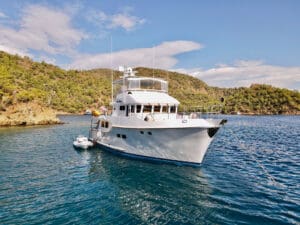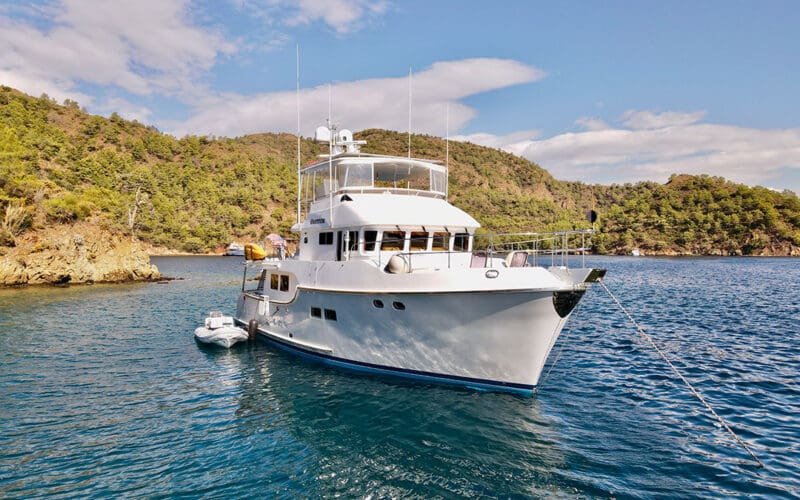By Laurie Thyrre
 We are planning to cross in 2025 aboard our Nordhavn 64 Gratitude and we need to decide whether to go left or right (from the Azores). This is the question that every voyager must ask when crossing the Atlantic from North America to Europe and it isn’t as straight forward to answer as one might expect.
We are planning to cross in 2025 aboard our Nordhavn 64 Gratitude and we need to decide whether to go left or right (from the Azores). This is the question that every voyager must ask when crossing the Atlantic from North America to Europe and it isn’t as straight forward to answer as one might expect.
Due to the lovely Bermuda/Azores high pressure that dominates the North Atlantic in the month of May, most people will opt to cross eastbound at this time. Logical stops for weather or fuel are Bermuda and the Azores. But from there, which is the best route to explore?
When we crossed the Atlantic in 2019, we did so in the company of another boat and we opted to go north to Ireland, while they opted to head south to Gibraltar. The distances are nearly identical so what follows are some factors to take into account if you are planning to make the journey. How long will you explore Europe? What is your own tolerance for change and weather? Will you be traveling back to the US? And finally, do you plan to winter over someplace or would you prefer to keep moving? Let’s unpack them one by one:
How long do you plan to explore Europe? This is a big consideration since you will want to prioritize your “must see” destinations earlier in the voyage. We have met dozens of cruising families who have unexpectedly cut short their plans due to a family emergency, change in family status or just because they ran out of steam. Since we don’t know what we don’t know, better to prioritize the “must see” places first, in case life gets in the way. That said, your own tolerance for change and weather should be considered.
We are Florida people, we are keenly aware that we would generally prefer to be hot than cold, so though we wanted to start with Ireland and England and had hoped (but never made it) to see Scotland for the first summer, we knew that spending the winter in England might short circuit the entire venture. So, we booked marina reservations for Lagos, Portugal which; though cool in the winter, was sunny and the perfect place for us to acclimate to this new life. We had planned to head back north to explore the Baltic for our second summer but COVID 19 happened and the only countries accepting European visitors were in the Med. Flexibility being the biggest determinant to enjoying your new life, we put the heading on 090° rather than 360° and went eastbound to Spain in the Med.
One’s tolerance for change is nearly as important as one’s tolerance for inclement weather. We set out on this adventure to learn and explore other countries and cultures but to be brutally honest, we wanted to enter in the shallow end first (England) and slowly acclimate to the more exotic living circumstances. We packed on board those things that we thought were important for the first several holidays and birthday celebrations, knowing that we may not be able to get some products overseas, but I chuckle when I see deodorant that I loaded on board five years ago. Making the adjustment to living overseas will be different for every family. For our family, we decided that landing in an English-speaking part of the world with products and services we are accustomed to, would be the optimum way to avoid too much culture too soon.
Undoubtedly, one of the first elements to consider is the legal requirements for yourselves, your boat, and any pets with whom you intend to travel. Let’s start with the humans first: Every country and/or group of countries has their own policy about for how long you may remain without a visa. In Europe, there are three big considerations. The Schengen Area, the EU area, and the individual country requirements.
Most Americans are familiar with the EU so we will begin there. The humans are permitted 90 days out of 180 days and they look backward from the date of your arrival/departure. To clarify, you may not exceed 90 days in the ENTIRE EUROPEAN UNION in the past 180 days. For Americans, Brexit was a wonderful thing because now we have a place to get out of the EU to allow our time to reset in the northern part of Europe. Some countries are not members of the EU but are members of the Schengen Agreement. The same rules apply for those countries in that you may not exceed 90/180 days. Norway for example is a member of the Schengen agreement but NOT a member of the EU. It is incumbent on each passport holder to ensure their own compliance with each area/countries’ requirements. If you intend to fly back and forth to the US for various seasons/reasons, you will likely be able to reset your own clock by heading home.
In that case, you will want to familiarize yourself with the EU requirements for your vessel. Each country has its own requirements for importing a boat but the EU will impose HUGE taxes on any vessel that remains in their waters for more than 18 months. During COVID 19 when many owners were unable to return to their boats, a cottage industry sprang up to move boats out of the EU for the day.
And finally, pets. We entered into Ireland because we were able to get a pet passport from a veterinarian thereby giving our cats permission to travel throughout the EU. Entering the UK with pets is more challenging than Ireland. I would urge you to do your research if you are considering this option. Options in the north for getting out of the EU and Schengen Areas are the UK and Russia – that’s it. In the Med, you can go to Gibraltar, Montenegro, Turkiye, Tunisia and Morocco to name a few but just because you can go to a place to reset your immigration clock, doesn’t mean you will want to.
If it is your plan to travel 12 months a year, you will want to take into consideration where you will go to reset your own immigration clock as well as the boats as above but, weather and your own tolerance for inclement weather will be the biggest factors. In our four years in Europe, we have only met two people who traveled year-round. Aboard Gratitude we decided early on that stopping for four to six months in the winter was the way to go. Chief among considerations for us is that our son Jack is still in school. Having a place to settle in for a period of months was crucial for us accomplishing school and establishing a routine. After months of traveling, knowing where in town we would find our favorite coffee or ice cream was grounding and a perfect respite from the non-stop movement in the summer months. The weather in the higher latitudes is not conducive to regular movement and if 365 cruising appeals to you, you may have better luck finding longer weather windows in the Med. A final consideration for staying in one place for the winter is the favorable marina contracts available for longer term stays. Booking in for five months in the winter usually involves significant discounts over the daily or monthly berthing of the year-round cruising schedule.
As we now embark on our fifth summer of cruising in Europe, we are finally set to cruise to the Scandinavian countries we had planned to see in our second summer. To accomplish this feat, we had to creatively employ the services of a crew to move Gratitude from Turkiye to England, thereby preserving our precious EU/Schengen time to enjoy the summer of our dreams. Given that we are planning to return to the US next summer, this was our final opportunity to see the fjords of Norway and the charming towns of Denmark from the comfort of our own home. A chance we couldn’t miss!
Before you set out on your own great explore, what are your desires and goals. Make your own way based on some contemplation of where you and your family are most likely to thrive, then find a way to make it work.
Laurie Thyrre, a retired airline pilot, voyages with her husband and son aboard their Nordhavn 64 Gratitude.

